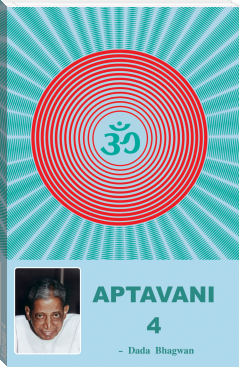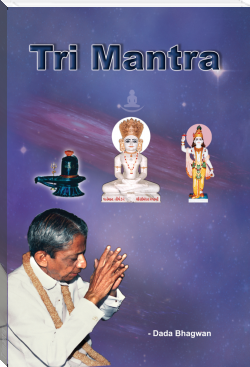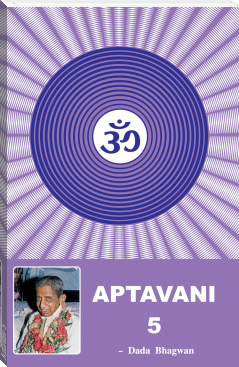Aptavani-4, Dada Bhagwan [ebook reader library .TXT] 📗

- Author: Dada Bhagwan
Book online «Aptavani-4, Dada Bhagwan [ebook reader library .TXT] 📗». Author Dada Bhagwan
[11] The Atma and The Ego
“I am ‘Chandubhai’, I am the husband of this woman, I am the father of this boy, I am a businessman, I am fat, I am fair-skinned…etc.” These and many such countless ‘wrong beliefs’ have been covering up one’s own ‘right belief’, one’s own pure vision and pure knowledge. The Gnani Purush fractures those ‘wrong beliefs’, and unveils all the covers: opening that magnificent portal to ‘right vision’ – Self-realization!
The ego is the ‘ignorant’ proclamation of “I did”, where one is not the ‘doer’. And because of the ego, there is bondage of karma, bondage of body, bondage of mind, and bondage of speech. Any bondage of the non-Self complex(pudgal) is attributed to the ego.
To worship the Soul(Atma) and the absolute Soul(Parmatma) as being separate, is the way of the worldly, ‘relative’ religions. And to worship the Atma and Parmatma as one (not separate), is the religion that transcends beyond the world (alaukik); and from the ‘real’ religion comes Moksha! In the real religion, there is no merit karma (punya) or demerit karma (sin; paap); there is no ‘doership’ of anything at all!
One becomes ‘certified’ for moksha, when one’s worldly pleasures and happiness become a heavy load of pain and suffering! The Gnani Purush gives one moksha, because the Gnani Purush is the ultimate liberator.
[12] Arrangement of Vyavasthit
The regulation of the universe happens naturally and on its own. The ‘Akram Gnani’ calls it “vyavasthit shakti orscientific circumstantial evidence”. This “scientific circumstantial evidence” has no control over the six eternal elements in the universe. All the elements are independent; they do not recognize each other, they do not obey each other even though one of them the element of the Self(chetan), is the Parmatma itself!!!
If surrender and ‘selfless service’ went hand in hand, that would be excellent. But the result of service is merit karma, and not moksha. Yes, if there is Self-realization, there is no ‘doership’ and therefore no bondage of karma.
The world is replete with bloodshed, cruelty, violence, fighting, massacres and the agonizing outcome of world wars. The Gnani Purush sees these as ‘scientific circumstantial evidences’ (vyavasthit)! Who pays attention to the violence and death occurring in the ocean amongst the big fish and small fish? Is that also not ‘scientific circumstantial evidences’?
[13] Religion of the World: Religion of the Self
Worldly religion is where one receives pleasure from giving pleasure to others, and if one gives pain, one will receive pain in return. Do people not get security for their lives when they follow the rules of traffic laws? If one does hurtful action(adharma), he will have a ‘collision’ and get into an accident! Thus, to get the security of happiness, one gives happiness to others, and therein lays the secret of the “relative” religions! In the “real” religion (Atma-dharma) however, one has to attain the Self.
When there is a solution available in all circumstances, it is called ‘real’ religion. When there is a solution or even a lack of solution, it is called ‘relative’ religion.
While looking for eternal happiness, and in not finding it, a living being(jiva), springs into imaginary happiness, and because that imaginary happiness results in pain, he attempts various ‘imaginary’ endeavors, only to become more and more entangled! Eternal bliss exists only within the Self! To attain true happiness or eternal bliss, one has oneself to become ‘true’. To attain worldly happiness, however, one has to become ‘worldly’!
Once a living entity enters the passage of flow in the universe (samsaran marg), it experiences relentless internal burning and suffering. One’s worldly life ceases when this ‘burning’ is quelled.
As long as there is a balance between inner happiness and outer happiness, there will be peace in one’s worldly interactions. The outer happiness is enjoyed at the cost of inner happiness. As a consequence, a person loses his mental stability, to the extent that he becomes reliant on sleeping pills.
Where there is not the slightest vestige of pain; there is the Self (the Soul).
With wrong vision (viparit darshan) there is pain: with the right vision (samyak darshan) there is bliss, bliss, and nothing but bliss!
Complete surrender under the Gnani’s protection is the vehicle for moksha; however, for the worldly happiness one should serve one’s parents and one’s guru.
In people’s understanding, happiness lies in loksangnya (related to other peoples’ beliefs). In the Gnani’s understanding, happiness lies in the Atma.
Saints (santo) take pleasure in pain whereas the ‘Gnani’ takes pleasure in the Self. Saints proceed believing pain as pleasure.
To derive pleasure from the body (pudgal; non-Self complex) is a ‘borrowed’ transaction that you will have to ‘repay’. When the son jumps onto his lap saying, “Daddy…daddy,” the father enjoys ‘borrowed’ pleasure. But when the same son grows up and says, “Dad, you have no sense!” the time has come for that borrowed pleasure to be ‘repaid’! So why not be cautious from the very start? The pudgal is itself vitarag (without attachments and abhorrence) but when the ‘self’ (relative self) acquires, the transaction of borrowing begins!
[14] The True Understanding of Religion
The traditionalworldly (laukik) religions give worldly happiness and the real (alaukik; beyond the world) religion gives eternal bliss. All actions carried out in the presence of ignorance of the Self (mithyatva), materialize in the worldly life. Religion that is beyond the world is not found in renunciation (tyaag) nor is it found in pleasure (bhoga). ‘That which is renounced, will be met with ahead.’ One can accumulate as much burden as one can carry! True renunciation, is that which helps get rid of artadhyan (adverse internal meditation that hurts the self), and raudradhyan (adverse internal meditation that hurts the self and others)!
That which protects you in your troubled times is religion(dharma)! At the time of artadhyan and raudradhyan,true religion will be ever present for our protection! For endless lifetimes, people have followed religion but if they did not receive any protection in their time of need, how can one call this following a religion? If one experiences worries, then it can be said that one has not understood religion at all.
Whatever becomes religion, and yields results, is called religion. Whenever someone shouts abuse or curses, religion is there to help us! Religion yields results; whereas non-religion does not. One, who maintains equanimity in times of trouble, receives the stamp of approval to attain liberation( moksha).
One does not have to ‘follow’ (ritualized activity) religion; one has to remain sincere to religion (dharma). While doing the Lord’s darshan in a temple if at the time the person ‘sees’ (thinks about) his shoes that he left at the entrance, or thinks about his shop, how can he be considered sincere? True religion is one that gives one freedom from all types of pain.
The one and only path to moksha is through Gnan (knowledge), vision(darshan), conduct (charitra) and penance ( tapa): there is no other path.
For infinite lifetimes, one paid devotional observation(darshan) to the ‘form’ (murta – the physical; tangible form). If only once, the darshan of the ‘formless’ (amurta) occurs within a person, the losses of infinite lifetimes are made up.
When can all these losses be made up, and that too in this insolvent Kaliyug (the current fifth era)? That is why one should just accept the Gnani’s protection (sharanu) and ask him for liberation. Only then can everything be resolved in a short time.
[15] Dharma in One’s Conduct
The Lord does not look at the conduct (activity of mind, speech and body), but He does give significance to the intent (bhaav). Conduct ( aacharan) is “discharge” karma, and the “charge” (of new karma) happens according to the intent behind the action.
The constant contemplation of ‘Life as a human should not go in vain’ will someday bear fruit.
To be free from conflict is the greatest religion. There is no religion where there are clashes, and there are no clashes where there is religion.
Show kindness (daya), remain peaceful (shanti), remain in equanimity (samata). These dictates of religions, are futile in these current times. What can be done when they cannot be observed even after millions of attempts? That is why the Gnani Purush shows us a new path, in a new form; one that is attainable even by the common person.
When anger, pride, deceit and greed (kashays) happen, it is not a problem, but one should do repentance(pratikraman) for them. If you commit a theft, it is not a problem, but you must do pratikraman for it. If you just abide this one Agna (special directive) of theGnani, you will attain the essence of all religions. There is no other higher religion, than to please the Gnani. Nothing else pleases the Gnani more than if you follow his Agnas! Only the Gnani’s Agnas can take one to the ultimate moksha!
Knowledge itself brings action. As soon as the knowledge that ‘It is fun to steal’ becomes instilled, one will begin to steal. The action always changes as the knowledge changes! Without changing the knowledge, the actions will never change, even after millions of lifetimes!
For knowledge of ignorance (worldly knowledge), the energies are easily facilitated by the pudgal (body or non-Self complex). This energy is easily wasted in theft, violence and carnal pleasure. However, for the attainment of Gnan (knowledge of the Self), prayer and independent efforts are necessary! Prayer means asking for the higher meaning of it all, and one can ask for this from one’s own Self or from the Gnani. In the ‘ignorant’ stage (when one has not attained Self-realization), one can pray to one’s guru, an image of God, or one’s favorite deity. A true prayer, done by a person with a pure heart, will always be successful.
[16] Relative Religion: Spiritual Science
Where there is impartiality, there is the religion of the Vitarag (one who is free from attachment and abhorrence). The Vitarag religion is the religion of siddhants (irrefutable principles that accomplish the ultimate). That which is experienced by the senses, is “relative”. And the ‘relative’ has arisen only because there is the Real! The ‘relative’ is in the form of situations (avastha) and the ‘real’ is in the form of eternal elements (tattva swaroop).
Relativity – Mudhatma; the state of the Soul in the ignorance of the Self involved in religion or non-religion.
Reality – Gnanghan Atma (The Self with Knowledge; antaratma; the interim soul that is awakened to the Self).
Absolute – Vignanghan Atma (The Soul with the Knowledge of Science; the Parmatma – The Absolute Soul)
The essence of the world (jagatsaar) is the enjoyment of sensual pleasures. The essence of religion (dharmasaar) is to be free fromartadhyan (adverse internal meditation that hurts the self) and raudradhyan (adverse





Comments (0)